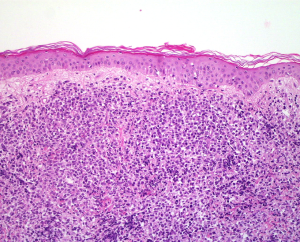Elucidation of the Genetic Basis of Cutaneous T Cell Lymphoma
 Figure 1. Histology of Tumor Stage CTCL.
Figure 1. Histology of Tumor Stage CTCL.
Cutaneous T cell lymphoma is an incurable non-hodgkin lymphoma of the skin-homing T cell. Disease progresses from skin-limited patches and plaques. In advanced disease, tumor cells metastasize to the blood and lymph nodes. Patients with advanced disease eventually succumb to a combination of tumor burden and immunosuppression.

Figure 2. Complex Genomic Rearrangements in CTCL Identified by Whole Genome Sequencing.
We have recently elucidated the genomic landscape of cutaneous T cell lymphoma using whole exome sequencing, whole genome sequencing, and RNA- sequencing of CTCLs. We found mutations that occurred more often than expected by chance and conclusively implicated genes involved in T cell homeostasis as well as cancer signaling pathways. The putative driver genes are components of the DNA damage, chromatin modifying, NF-kB, and the T cell receptor signaling pathways. We are currently employing a comprehensive approach using human tissues and animal models to investigate the functions of these genes. We are confident these studies will allow us to elucidate the pathophysiology of this cancer and lead to the identification of novel therapeutic targets.
Future Directions
We are currently employing a multidisciplinary approach to identify disease mechanisms and potential targetability. We are using next-generation sequencing, mouse models, and human patient samples to translate observations from patients to testable hypotheses with the goals of developing novel therapeutic strategies.
Reference: Choi, et al. Nature Genetics. 2015.
Daniels, et al. Nature Communications. 2020.
In the news:
Nature Research Cancer Community.
Related Papers from the Choi lab:
CTCL-Associated POT1 Mutations Promote Lymphomagenesis
Utilization of TCR V-Beta Panel in the Diagnosis and Treatment of CTCL